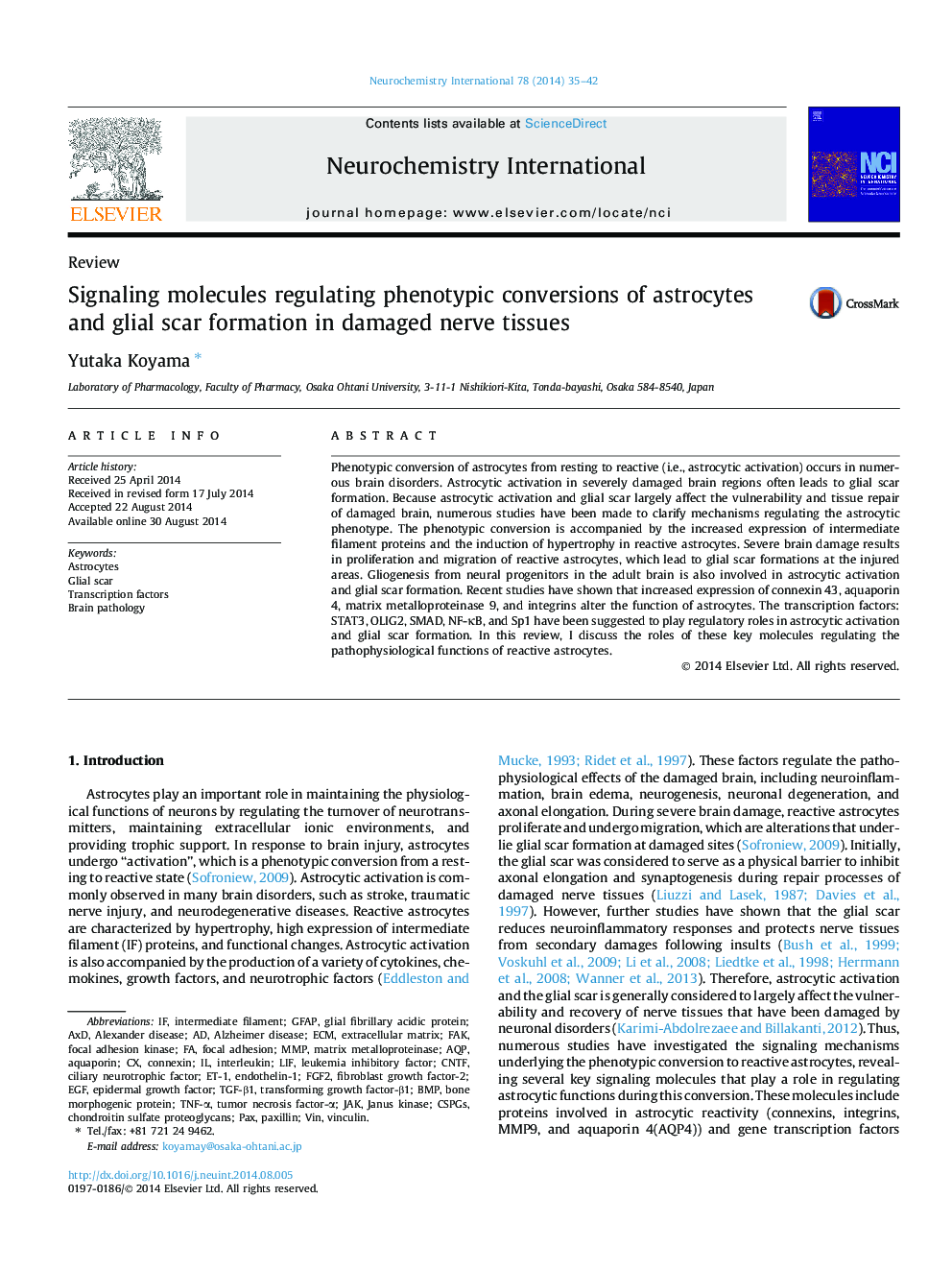| کد مقاله | کد نشریه | سال انتشار | مقاله انگلیسی | نسخه تمام متن |
|---|---|---|---|---|
| 8479189 | 1551295 | 2014 | 8 صفحه PDF | دانلود رایگان |
عنوان انگلیسی مقاله ISI
Signaling molecules regulating phenotypic conversions of astrocytes and glial scar formation in damaged nerve tissues
ترجمه فارسی عنوان
مولکول های سیگنالینگ تنظیم تبدیل فنوتیپی از آستروسیت ها و تشکیل اسکار گلیه در بافت عصبی آسیب دیده
دانلود مقاله + سفارش ترجمه
دانلود مقاله ISI انگلیسی
رایگان برای ایرانیان
کلمات کلیدی
PAXAQPFGF2CSPGsET-1AxDCNTFVinculinFAKPaxillinGFAPECMMMPEGFTGF-β1LIFJanus kinase - کیناز جانوس Astrocytes - آستروسیتbrain pathology - آسیب مغزیaquaporin - آکواپورینGlial scar - اسکار گلیالendothelin-1 - اندوتلین-1interleukin - اینترلوکینAlzheimer disease - بیماری آلزایمرalexander disease - بیماری الکساندرTransforming growth factor-β1 - تبدیل فاکتور رشد β1tumor necrosis factor-α - تومور نکروز عامل αintermediate filament - رشته های متوسطVIN - شرابepidermal growth factor - عامل رشد اپیدرمیleukemia inhibitory factor - عامل مهارکننده لوکمیTranscription factors - عوامل رونویسیciliary neurotrophic factor - فاکتور نوروتروفیک ciliaryTNF-α - فاکتور نکروز توموری آلفاfibroblast growth factor-2 - فیبروبلاست رشد فاکتور 2Extracellular matrix - ماتریکس خارج سلولیmatrix metalloproteinase - ماتریکس متالوپروتئینازBMP - مدیریت فرایند کسب و کارGlial fibrillary acidic protein - پروتئین اسیدی فیبریلاسیون گلایالbone morphogenic protein - پروتئین مورفولوژیک استخوانChondroitin sulfate proteoglycans - پروستاگلایسینهای سولفات کلسترولFocal adhesion - چسبندگی کانونیJAK - چگونهconnexin - کنسکسینfocal adhesion kinase - کیناز چسبندگی کانونی
موضوعات مرتبط
علوم زیستی و بیوفناوری
بیوشیمی، ژنتیک و زیست شناسی مولکولی
بیولوژی سلول
چکیده انگلیسی
Phenotypic conversion of astrocytes from resting to reactive (i.e., astrocytic activation) occurs in numerous brain disorders. Astrocytic activation in severely damaged brain regions often leads to glial scar formation. Because astrocytic activation and glial scar largely affect the vulnerability and tissue repair of damaged brain, numerous studies have been made to clarify mechanisms regulating the astrocytic phenotype. The phenotypic conversion is accompanied by the increased expression of intermediate filament proteins and the induction of hypertrophy in reactive astrocytes. Severe brain damage results in proliferation and migration of reactive astrocytes, which lead to glial scar formations at the injured areas. Gliogenesis from neural progenitors in the adult brain is also involved in astrocytic activation and glial scar formation. Recent studies have shown that increased expression of connexin 43, aquaporin 4, matrix metalloproteinase 9, and integrins alter the function of astrocytes. The transcription factors: STAT3, OLIG2, SMAD, NF-κB, and Sp1 have been suggested to play regulatory roles in astrocytic activation and glial scar formation. In this review, I discuss the roles of these key molecules regulating the pathophysiological functions of reactive astrocytes.
ناشر
Database: Elsevier - ScienceDirect (ساینس دایرکت)
Journal: Neurochemistry International - Volume 78, December 2014, Pages 35-42
Journal: Neurochemistry International - Volume 78, December 2014, Pages 35-42
نویسندگان
Yutaka Koyama,
